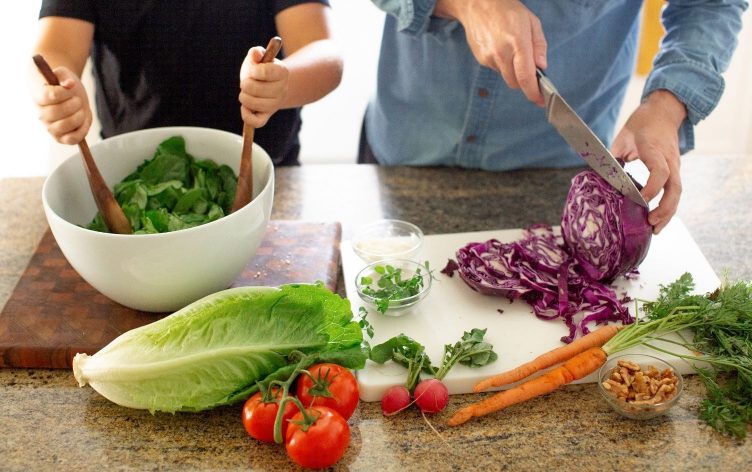
10 Things to Know Before Trying the Volumetrics Diet
The volumetrics diet topped the list of U.S. News and World Report’s Best Diets for 2022, coming in at No. 1 for Best Weight Loss Diet and No. 5 for Best Overall. So what exactly is it, what do you need to know about it, and is it right for you? Here are 10 things to know before diving into the volumetrics diet.
YOU DON’T HAVE TO COUNT CALORIES
The premise of the volumetrics diet is more of a concept or nutritional approach than a strict diet plan. Food is not weighed, calories are not counted, ingredients are not logged, macros are not calculated. Emphasis is placed on enjoying a high volume of fruits, vegetables, beans and other foods high in fiber and with a high ratio of water content.
UNDERSTANDING SATIETY AND ENERGY DENSITY ARE KEY
As the name implies, the focus of this diet is on foods you can eat in maximum quantity for minimal calories. The volumetrics diet emphasizes foods high in volume and nutrient density but lower in energy (aka calorie) density. Think plants: fruits, greens, grains and vegetables that tend to contain lots of water and be much bigger in volume than their calorie and weight-equivalent of processed foods, meats, fats, and higher fat dairy products.
The basic idea is by filling up on a large volume of nutrient-dense (but low-calorie) foods, you won’t go hungry.
Three key components affecting satiety are water content, fiber content and nutrient density.
Most plant-based foods are about 80-90% water. We often mistake hunger for thirst, but when you replace a large portion of your meals and snacks with fruits, veggies, whole grains and broth-based soups, you get a lot more bang for your calorie buck.
Look at grapes versus raisins. Two cups of grapes have around 120 calories — the equivalent calorie profile of about 1/4 cup of raisins!
The more fiber a food has the more satiating it is; fiber not only keeps you full and satisfied longer but also helps regulate blood sugar and keeps insulin levels more stable. Another bonus: Fiber feeds the good bugs in your gut, and a healthy gut not only boosts immunity but also helps with digestion and brain cognition.
FOOD IS SEPARATED INTO FOUR CATEGORIES
The first category in the volumetrics diet is very low energy density foods, including most fruits and non-starchy vegetables (green beans, onions, mushrooms, broccoli), broth-based soups, and nonfat milk and dairy products. These are considered “free” foods.
The second category is low energy density foods such as starchy vegetables (sweet potatoes, carrots, butternut squash), whole grains, beans, and low-fat proteins.
The third category is medium energy density foods such as higher-fat meats, cheeses, breads and refined grains, salad dressings and other high-fat foods like pizza. These foods should be carefully portioned when consumed.
The fourth category is high energy density foods such as desserts, fried foods, butter, oil, cookies, candy and fast foods. These are all foods that should be eaten on rare occasions.
While there are no “off-limit” foods, the idea is to modify how often you eat foods from each category — sticking mostly with foods in the first and second category, being mindful of foods in the third category, and mostly avoiding those in the fourth.
THERE’S ACTUAL SCIENCE BEHIND THE DATA
The volumetrics diet was created by Dr. Barbara Rolls, a nutrition science researcher and professor at Pennsylvania State University. Dr. Rolls’ intention was to create a new approach to eating — one that emphasized healthier eating patterns rather than a restrictive dieting regimen. Her research has consistently found people on a lower-calorie density diet could consume 1–2 pounds more food each day in comparison to people not on a reduced-calorie density diet.
IT’S ONE OF THE FEW DIETS THAT SUPPORTS LONG-TERM SUSTAINABLE WEIGHT LOSS
There’s a reason this diet has been top-ranked for more than a decade. Unlike many of the extreme elimination diets (like keto, Paleo and Atkins), the volumetrics diet is consistently credited for its ability to be maintained long term. The diet was originally designed to produce long-term weight-loss results by eliminating the deprivation that so often comes with dieting. Translation? Few people go hungry on the volumetrics diet.
A 2016 meta-analysis of 13 different studies found a common link between low-density foods and weight loss. One of the main reasons people stop dieting or change their eating patterns is because they get hungry. The volumetrics diet encourages high volumes of certain foods so you don’t experience hunger pangs and “hangry” mood swings.
FATS AREN’T THE MAIN FOCUS
One of the downsides of this diet is that healthy fats like olive oil, nuts, nut butter, avocado and fatty fish take a backseat. Good fats not only satisfy and keep you full (satiety!) but also protect your heart and support overall health. In fact, these foods help absorb all of those important fat-soluble vitamins (A, D, E and K) found in all of the plant-based foods promoted in the volumetrics diet. Fats also add flavor to veggies, grains and even lean proteins. It’s important to eat a moderate amount of heart-healthy fats in any diet. Use plant-based oils to cook and sear lean proteins, wilt greens and caramelize vegetables.
PROTEIN PLAYS A SMALLER ROLE
The body requires protein for everyday growth and cell functions; it helps build and repair muscle tissue and can keep you fuller for longer. However, the volumetrics diet puts a smaller emphasis on protein because foods high in protein can also be calorie-dense — including many cuts of meat, fatty fish, eggs, nuts and high-fat dairy. A restaurant portion of steak can be as much as 12 ounces (or 3/4 of a pound) — and those calories add up quickly. The volumetric diet encourages portioned amounts of lean protein sources in categories 2 and 3 such as fish, chicken, turkey, eggs, tofu and beans.
CARBOHYDRATE QUALITY COUNTS
Whole grains (a category 2 food) are emphasized over refined grains (category 3) in the volumetrics diet. Unlike simple carbs (i.e., white bread or white-flour pasta), complex carbs found in whole grains are more satiating, have more fiber, and take longer to digest, meaning they won’t spike your blood sugar. It’s best to choose unprocessed whole grains like brown rice, quinoa, oats, farro and whole-wheat bread. These are higher in protein, water and fiber, helping slow the absorption of sugar in the bloodstream. Vegetables can also be used to bulk up the volume of whole grains and cut calories; like adding cauliflower rice to traditional rice or zucchini noodles to pasta.
IT CAN HELP STABILIZE SUGAR
The volumetrics diet is one of the top diets used to manage and prevent diabetes. More and more research points to low-density diets as the top way to prevent insulin resistance. When you make non-starchy vegetables and broth-based soups the center of attention, you put more focus on foods that don’t spike insulin and cause other metabolic issues that lead to diabetes (and other health problems).
IT COULD IMPROVE OVERALL HEALTH
Load your plate first with lower energy density foods, like green salads, fruits, whole grains and vegetables; then, fill in with a small amount of protein and heart-healthy fats. Eating more plant-based foods is linked with lower levels of inflammation, improved heart health, and decreased risk of other diseases like diabetes and even some cancers. Since the volumetrics diet encourages you to eat more plant-based foods and less processed foods, it could positively affect your overall health.
There is quite a bit of food prep and planning involved in the volumetrics diet. But MyFitnessPal is here to help! We have hundreds of recipes to help fuel your low energy density needs.
A day on the volumetrics diet might look like this:
Breakfast: Golden Overnight Oats With Blueberries or Broccoli Pesto Omelet With Mixed Greens
Snack: Yogurt, Berry and Chia Parfaits
Lunch: Bento Box Chicken Salad or Chicken Tortilla Soup
Snack: Bowl of popcorn or carrot sticks with hummus
Dinner: Turkey Bolognese With Zucchini Noodles or Sheet Pan Pork With Butternut Squash and Kale
THE BOTTOM LINE
The volumetrics diet is a great solution for anyone looking for a sustainable, long-term plan for healthy eating. If you lean on whole, plant-based foods and prefer high volume over restrictive eating, you may be a great candidate for the volumetrics diet. Just be sure to work in enough heart-healthy fats and lean proteins to help fill you up and meet your daily needs.





